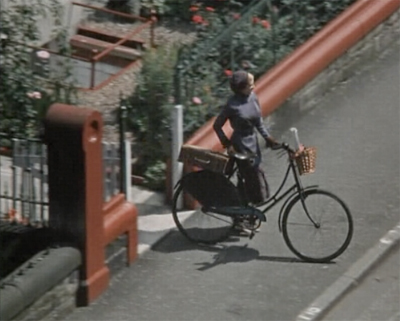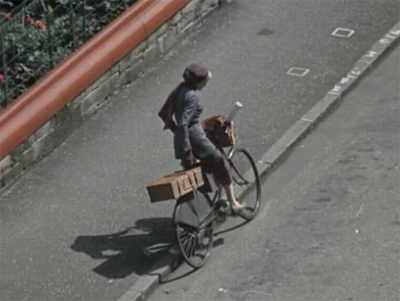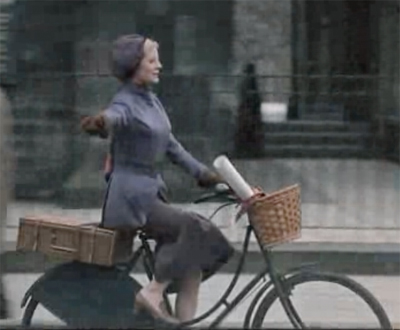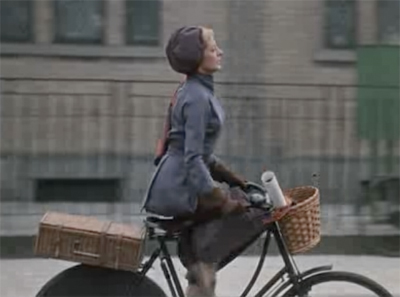Over the holidays I received a DVD of a film diptych that I'd long wanted to watch:
Cycling the Frame and
The Invisible Frame, directed by Cynthia Beatt.
In 1988, Beatt made the short film
Cycling the Frame. Described as a "cine-poem," this 30 minute documentary follows a young British actress (Tilda Swinton) as she cycles along the perimeter of the Berlin Wall in what was then West Berlin. It is a 100 mile journey along mostly abandoned roads and overgrown dirt paths crossing forests and fields. The ever-present wall, with its menacing guard towers, turns the landscape surreal: It severs railroad tracks, creates paths to nowhere, and separates waterfront properties from the bodies of water they front. As Swinton pedals, she vocalises her stream-of-conscience thoughts about the things she sees and how they make her feel. As she grows tired of cycling and overwhelmed with her surroundings, the film begins to resemble a dream sequence. Finally she arrives to her Brandenburg Gate start and concludes that "this place is mad."
More than two decades after the original journey, the director and actress set out again to film the follow up,
The Invisible Frame. In 2009, they retrace their route along the now long-absent Berlin Wall. A visibly more mature, sharper dressed Tilda Swinton cycles the perimeter, this time weaving back and forth across the phantom border. There are signs of life now: The roads have bike lanes and motorised traffic. On some of the dirt paths we see joggers, dog walkers, children and other cyclists. But despite an apparent return to normality along these stretches, the majority of the landscape is no less eerie twenty years after the wall's removal. We see abandoned buildings, barren fields, dingy looking lakes, random bits of strangeness. It's as if scarred, dead space remains left where the separation used to be. Disconcerted, Swinton meditates on this as she pedals, concluding that "when one wall comes down others come up."
While these aren't cycling films exactly, the prominent role of the bicycle is impossible to ignore. From a practical standpoint, a bike was necessary to make the films happen. Much of the route along the real/ phantom Wall is not accessible to cars, and traveling 100 miles on foot would not have worked with the scope of the project. The speed of the bicycle matched the speed with which the narrative needed to flow, and even the camera crew traveled via a
cargo recumbent. As each film progresses, the bicycle begins to seem increasingly important, merging with Swinton's visceral sense of self. She starts to mention it in her stream-of-conscience utterings, to talk about space in relation to not just her, but to her and the bike, to confuse herself with the bike. While this contributes to the mystical feel of the films, it will also be recognised by cyclists as a completely normal sensation to have during long rides.
It was interesting also that the bicycle seemed well-matched to Swinton's person in each of the films. In the original, the actress's flowing clothing looks worn and a little disheveled; her hair natural and slightly unkempt. The bike she rides is a rickety swoopy mixte with faded paint. In the newer film, Swinton is dressed in a stylized and sophisticated manner. She wears architectural-looking clothing and shoes. There are sharp angles to her haircut, her hair now a platinum blond. The bicycle she rides is angular and modern, its paint metallic. This transformation in personal style and bike echoes the rift I felt between the earlier and the latter films.
Cycling the Frame came across as spontaneous and exploratory, whereas
The Invisible Frame seemed stiffer and more choreographed. The actress/cyclist is no longer the same person and does not relate to this landscape in the same way. She talks about openness, but speaks in political and philosophical generalities and is seemingly less present in Berlin itself.
Can we ever recreate an experience, or re-visit a place? And can we ever really understand another country, as we tour it on a bike with a foreigner's benign detachment and predatory curiosity? These are the questions these films, with their collective 200 miles of cycling along a real/ unreal wall perimeter, ultimately seem to be asking.
If you are local and would like to borrow my copy, drop me a line.
The Invisible Frame can be viewed on netflix, but the original
Cycling the Frame was not available online last time I checked.














